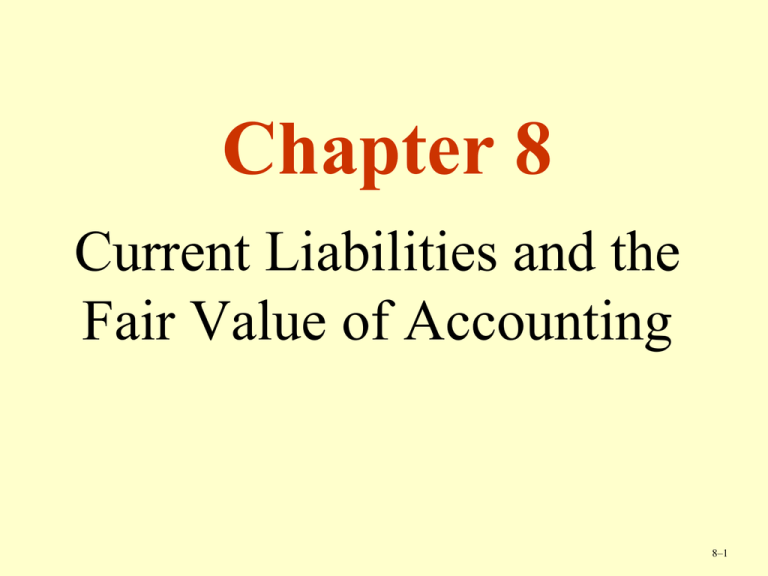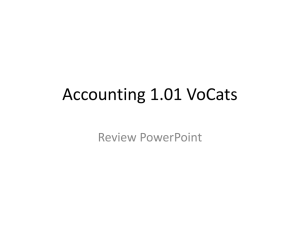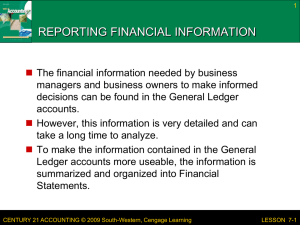
Chapter 8
Current Liabilities and the
Fair Value of Accounting
8–1
Microsoft
Microsoft is the
world’s leading
computer software
company.
Reported $23.8 billion
in total liabilities in
2007 or about 75.5
percent of its
stockholders equity of
31.1 billion.
© Royalty Free/ Corbis
As you study this chapter, consider how Microsoft maintains
liquidity and manages its debt
Visit Microsoft.com Investor Relations
Copyright © Cengage Learning. All rights reserved.
8–2
LO1: Managing Liquidity and Cash Flows
Current liabilities arise to
support the operating cycle or
to raise cash during periods of
inventory build up
Companies must be able to pay
debts
Measurements like working
capital and the current ratio
depend on current liabilities
The amount of time suppliers
give a company to pay for
purchases is also a factor in
managing cash flow and
liquidity
Copyright © Cengage Learning. All rights reserved.
© Royalty Free PhotoDisc/ Getty Images
8–3
Payables Turnover
Number of times, on average, that a company pays its
accounts payables in an accounting period
Payables Turnover =
Cost of Goods Sold + Change in Merchandise Inventory
Average Accounts Payable
Microsoft’s 2007
Payables Turnover
=
=
Copyright © Cengage Learning. All rights reserved.
$10,693 + $351
($3,247 + $2,909) ÷ 2
3.4 times
8–4
Payables Turnover for Selected
Industries
Copyright © Cengage Learning. All rights reserved.
8–5
Days’ Payable
How long, on average, a company takes to pay
its accounts payables
Days’ Payable =
365 days
Payables Turnover
Microsoft’s
Days’ Payable =
=
Copyright © Cengage Learning. All rights reserved.
365 days
3.4
107.4 days
8–6
Days’ Payable for Selected Industries
Copyright © Cengage Learning. All rights reserved.
8–7
Recognition of Liabilities
Timing is important when recognizing liabilities
Failure to record a liability often means that an
expense has also not been recorded
When an obligation
occurs, a liability
should be recorded.
Copyright © Cengage Learning. All rights reserved.
Transaction obligates company
to make future payments
Accrue liabilities like salaries or
interest payable
Estimate and accrue liabilities
like taxes payable
Agreements for future
transactions do not have to be
recognized
8–8
Valuation of Liabilities
Balance Sheet
Liabilities
Valued at the amount
needed to pay off the
debt, or at the fair market
value of the goods or
services to be delivered
© Royalty Free PhotoDisc/ Getty Images
Copyright © Cengage Learning. All rights reserved.
8–9
Classification and Disclosure
Current Liabilities
Debts and obligations that a
company expects to satisfy
within one year or within its
normal operating cycle,
whichever is longer
Companies may be required
to include additional
explanation of liability
accounts in the notes to the
financial statements
Maturity dates, interest
rates, special credit
agreements
Long-Term Liabilities
Due beyond one year or
beyond the normal operating
cycle
Copyright © Cengage Learning. All rights reserved.
8–10
Discussion: Ethics on the Job
Trimble Company accepts delivery of 20,000 units
of product that it intends to resell to its customers.
The invoice for $12,384.89 is delivered to the
accounts payable clerk. Since the amount is not due
until next month, she decides not to record the
amount in the books this month. This will help the
company’s financial position as it seeks to secure a
long-term loan for the purchase of a new building.
Q. If you were the accountant for this company,
what position would you take on this issue?
Copyright © Cengage Learning. All rights reserved.
8–11
Stop & Review
Q. Alpha Company purchased 50,000 gallons
of cleaning supplies on account in February.
The accountant decided not to recognize the
liability in that month, but postponed the
recognition of the liability until March.
Identify the ways in which the financial
statements have been affected.
A. Expenses have been understated, income has
been overstated, liabilities have been
understated, and owners’ equity has been
overstated for February.
Copyright © Cengage Learning. All rights reserved.
8–12
Stop & Review
Q. If a debt is due beyond the normal operating
cycle, should it be classified as long-term or
current?
A. It is a long-term liability if due beyond the
normal operating cycle.
Copyright © Cengage Learning. All rights reserved.
8–13
Stop & Apply
Q. Riddle Company reported cost of goods sold of
$936,305. Its inventory increased by $46,573.
Beginning accounts payable was $94,384 and
ending accounts payable was $99,353. What is
Riddle’s payables turnover?
A.
$936,305 + $46,573
($99,353 + $94,384) ÷ 2 = 10.1 times
Copyright © Cengage Learning. All rights reserved.
8–14
LO2: Definitely Determinable Liabilities
Current liabilities that are set by contract or statute
and that can be measured exactly
© Royalty Free PhotoDisc/ Getty Images
Copyright © Cengage Learning. All rights reserved.
Accounts Payable
Bank loans and commercial
paper
Notes payable
Accrued liabilities
Dividends payable
Sales and excise taxes payable
Current portion of long-term
debt
Payroll liabilities
Unearned revenues
8–15
Accounts Payable
Short-term obligations to suppliers for
goods and services
Also called trade
accounts payable
Amount in Accounts
Payable account is
generally supported by
an accounts payable
(A/P) subsidiary ledger
Copyright © Cengage Learning. All rights reserved.
A/P Subsidiary Ledger
Individual accounts for
each person or business
to which money is owed
8–16
Bank Loans
Companies often borrow funds when they are needed
using a line of credit
Company signs a note for
the full amount of a line of
credit
Company may use all or
only some of funds
Interest rate may change
daily
Bank may require firm to
meet certain financial goals
to retain its line of credit
Copyright © Cengage Learning. All rights reserved.
© Royalty Free/ Corbis
8–17
Commercial Paper
Short-term unsecured
loans available to firms
with excellent credit
ratings
Usually issued to the
public through
professionally managed
investment firms
Copyright © Cengage Learning. All rights reserved.
On the Balance Sheet:
Current Liabilities: The line
of credit currently borrowed
and the amount of
commercial paper issued are
usually combined with notes
payable in the current
liabilities section of the
balance sheet
8–18
Short-Term Notes Payable
Obligations represented by promissory notes
Used to:
Secure bank loans
Pay suppliers
Obtain more credit
© Royalty Free C Squared Studios/ Getty Images
Copyright © Cengage Learning. All rights reserved.
8–19
Recording Notes Payable
Issuance of 60-day, 12 percent promissory note on August 31
Aug. 31 Cash
10,000
Notes Payable
Issued 60-day, 12 percent
promissory note
10,000
Payment of note
Oct. 30
Notes Payable
Interest Expense
Cash
Payment of promissory note with $100
interest
10,000.00
197.26
10,197.26
60
$10,000 .12 365
$197.26
Copyright © Cengage Learning. All rights reserved.
8–20
Accrued Liabilities
Adjusting entries recognize liabilities that are not
already in the accounting records
Example:
A $10,000, 60-day, 12% promissory note is issued on
August 31. The fiscal year ends on September 30. The
interest to be accrued is calculated as follows:
$10,000 x .12 x 30/365 = $98.63
Sept. 30 Interest Expense
Interest Payable
To record 30 days’ interest
expense on promissory note
Copyright © Cengage Learning. All rights reserved.
98.63
98.63
8–21
Dividends Payable
Cash dividends are a distribution of earnings to a
corporation’s stockholders
A corporation’s board of directors has the sole
authority to declare dividends
A corporation has no liability for dividends until the
date of declaration
During the time between the date of declaration and
the date of payment, the dividends declared are
considered current liabilities
Copyright © Cengage Learning. All rights reserved.
8–22
Sales and Excise Taxes Payable
Sales taxes are often
levied on retail
transactions
Excise taxes are imposed
on certain goods like
gasoline
Merchants collect the
sales taxes from
customers and pay them
over to the appropriate
taxing authority
© Royalty Free Stockbye/ Getty Images
Copyright © Cengage Learning. All rights reserved.
8–23
Current Portion of Long-Term Debt
If a portion of long-term debt is due within
the next year and is to be paid from current
assets, that portion is classified as a current
liability.
Copyright © Cengage Learning. All rights reserved.
8–24
Payroll Liabilities
Payroll liabilities include:
Cost of
labor
Payroll
taxes
Salaries & Wages
FICA, Medicare, FUTA, and SUTA
Employers are responsible to various government agencies and
other entities for amounts withheld
Copyright © Cengage Learning. All rights reserved.
8–25
Payroll Costs
Copyright © Cengage Learning. All rights reserved.
8–26
Recording Payroll
Feb. 15: Record payroll, total employee wages, $65,000
Feb.15
Wages Expense
Employees’ Federal Income Taxes Payable
Employees’ State Income Taxes Payable
Social Security Tax Payable
Medicare Tax Payable
Medical Insurance Premiums Payable
Pension Contributions Payable
Wages Payable
To record payroll
65,000
10,800
2,400
4,030
942
1,800
2,600
42,428
Note that employees
earned $65,00 but
their take home pay
was only $42,428
Feb. 15: Record payroll taxes and benefit costs
Feb.15
Payroll Taxes and Benefits Expense
Social Security Tax Payable
Medicare Tax Payable
Medical Insurance Premiums Payable
Pension Contributions Payable
Federal Unemployment Tax Payable
State Unemployment Tax Payable
To record payroll taxes and other costs
Copyright © Cengage Learning. All rights reserved.
18,802
4,030
942
7,200
2,600
520
3,510
Payroll taxes and
benefits increase the
total cost of payroll
to $83,802
8–27
Unearned Revenues
Obligations for
goods or services
that the company
must provide or
deliver in a future
accounting period
in return for an
advance payment
from a customer
Deposits received
in advance, gift
certificates, and
subscriptions are
all current
liabilities
© Royalty Free C Squared Studios/ Getty Images
Copyright © Cengage Learning. All rights reserved.
8–28
Recording Unearned Revenues
Received advanced one year subscription totaling $3,600
Accounts Receivable
Unearned Subscriptions
Receipt of annual subscriptions in advance
3,600
3,600
Microsoft now has a liability that will be reduced gradually as monthly
services are provided
Monthly Service Performed
Unearned Subscriptions
Subscription Revenues
Delivery of monthly magazine issues
Copyright © Cengage Learning. All rights reserved.
300
300
8–29
Estimated Liabilities
Definite obligations whose exact dollar amount cannot
be known until a later date
Estimate
and record
these types
of liabilities
Income taxes
Property taxes
Promotional costs
Product warranties
Vacation pay
Copyright © Houghton Mifflin Company. All rights reserved.
8–30
Income Taxes Payable
A corporation’s income is taxed by the federal
government and most state governments
The amount of tax is not known until the end of the
year, but should be accrued in an adjusting entry
Dec. 31
Income Taxes Expense
Estimated Income Taxes Payable
To record estimated federal income taxes
*Numbers in millions
1,040*
1,040
Sole proprietorships and partnerships do not pay
income taxes; their owners pay on their individual tax
returns
Copyright © Cengage Learning. All rights reserved.
8–31
Property Tax Payable
Property taxes are levied
on real and personal
property
The fiscal years of local
governments and of
businesses rarely
correspond
Companies must estimate
the amount of property
tax applicable to each
month of the year
© Royalty Free Stockbye/ Getty Images
Copyright © Cengage Learning. All rights reserved.
8–32
Product Warranty Liabilities
When a firm sells a product or service with a warranty,
it has a liability for the length of the warranty
Illustration:
Midas Muffler guarantees that it will replace free of
charge any muffler it sells that fails during the time the
buyer owns the car. In the past, 6 percent of mufflers sold
have been returned for replacement. The average cost for
a muffler is $50. If the company sold 700 mufflers during
July, what is the amount of liability to be accrued?
700 X .06 = 42 x $50 = $2,100
Copyright © Cengage Learning. All rights reserved.
8–33
Recording Product Warranty Liabilities
Record warranty expense:
July 31
Product Warranty Expense
Estimated Product Warranty Liability
To record estimated product warranty
expense
2,100
2,100
Record replacement of a defective muffler, which cost $60,
and receipt of $30 service fee to have it replaced:
Dec. 5
Cash
Estimated Product Warranty Liability
Service Revenue
Merchandise Inventory
Replacement of muffler under warranty
Copyright © Cengage Learning. All rights reserved.
30
60
30
60
8–34
Vacation Pay Liability
Vacation pay is often accrued as employees work
during the year
The cost should be
allocated over the
entire year so that
month-to-month
costs will not be
distorted (applies
to bonus plans and
pension plan
contributions as
well)
© Royalty Free/ Corbis
Copyright © Cengage Learning. All rights reserved.
8–35
Vacation Pay Liability: Illustrated
April 20: Employees earn two weeks paid vacation for every
50 weeks worked, and it is assumed only 75 percent of
employees will ultimately collect vacation pay. The weekly
payroll is $42,000, of which $2,000 is paid to employees on
vacation. How is estimated vacation pay liability recorded?
Apr. 20
Vacation Pay Expense
Estimated Liability for Vacation Pay
Estimated vacation pay expense
1,200
1,200
($42,000– $2,000) .04 .75 $1,200
The computation of vacation pay expense is based on
the payroll of employees not on vacation
Apr. 20
Estimated Liability for Vacation Pay
Cash (or Wages Payable)
Wages of employees on vacation
Copyright © Cengage Learning. All rights reserved.
2,000
2,000
8–36
Stop & Apply
Q. What entry would be recorded to accrue interest
expense on a $4,000, 90-day, 12 percent note
issued on November 1 if the fiscal year ends on
December 31?
A. $4,000 x .12 x 60/365 = $78.90
Dec. 31
Interest Expense
Interest Payable
To record 60 days interest
expense on promissory note
Copyright © Cengage Learning. All rights reserved.
78.90
78.90
8–37
Stop & Review
Q. Which of these items are considered estimated
liabilities?
a) Property taxes
b) Payroll taxes
c) Income taxes
d) Dividends
A. Property taxes and income taxes
Copyright © Cengage Learning. All rights reserved.
8–38
Stop & Review
Q. Why are product warranties considered a
liability to the issuing company?
A. The company is responsible for replacement
of failing products and thus will incur costs.
These costs are to be held on the books as
potential liabilities.
Copyright © Cengage Learning. All rights reserved.
8–39
LO3: Contingent Liabilities
Potential liabilities that depend on future
events arising out of past transactions
Past Transaction:
Building of a
bridge
Future Event:
Outcome of a
lawsuit
Conditions for determining when a contingency
should be entered in the accounting records:
1. The liability must be probable
2. The liability can be reasonably estimated
(Vacation pay, income taxes, and warranty liability)
Copyright © Cengage Learning. All rights reserved.
8–40
Commitments
Legal obligations that
do not meet the
technical requirements
for recognition as a
liability and so are not
recorded
Examples include
purchase agreements
and leases
Copyright © Cengage Learning. All rights reserved.
© Royalty Free Digital Vision/ Getty Images
8–41
Stop & Review
Q. How does a contingent liability differ from a
commitment?
A. Contingent liabilities must be probable and
they must be able to be reasonably
estimated. Commitments do not meet these
requirements, but are legal obligations.
Copyright © Cengage Learning. All rights reserved.
8–42
LO4: Does Time Affect Money?
Time Value of Money
Effects of the passage of time on
holding or not holding money
Interest
Measures these effects for a given period of time
8–43
Interest
Simple Interest
Compound Interest
return on
principal for
one or more
periods
return on principal
for two or more
periods
principal sum
stays the same
from period to
period
computed by adding
the interest earned in
one period to the
amount on which
interest is computed
in future periods
8–44
Simple Interest Illustrated
Willy Wang accepts an 8 percent, $15,000 note due in
90 days. What total amount will Sanchez receive?
Interest Principal Rate T ime
8
90
$15,000
100 365
$295.89
The total that Sanchez will receive is $15,295.89.
($15,000.00 principal + $295.89 interest)
8–45
Compound Interest Illustrated
Terry Soma deposits $10,000 in an account that pays 6
percent interest. She expects to leave the principal and
accumulated interest in the account for three years. Interest
is paid at the end of each year. What total amount will be in
the account at the end of three years?
(1)
Year
1
2
3
(2)
Principal Amount
at Beginning
of Year
$10,000.00
10,600.00
11,236.00
(3)
Annual Amount
of Interest
(Col. 2 x 6%)
$600.00
63.6.00
674.16
(4)
Accumulated Amount
at End of Year
(Col. 2 + Col. 3)
$10,600.00
11,236.00
11,910.16
Soma will have $11,910.16 at the end of three years.
Note that the annual amount of interest increases each year
by the interest rate times the interest of the previous year.
8–46
Future Value Tables
The amount an investment will be worth at a
future date if invested at compound interest
Instead of calculating interest
period by period, future value
tables may be used
Periods 1%
3
1.030
4
1.041
5
1.051
6
1.062
2%
1.061
1.082
1.104
1.126
3%
1.093
1.126
1.159
1.194
4%
1.125
1.170
1.217
1.265
5%
1.158
1.216
1.276
1.340
6%
1.191
1.262
1.338
1.419
See Appendix B in your textbook for full present and future value tables.
8–47
Future Value of Single Sum
Using Tables
Terry Wang deposits $10,000 in an account that pays 6 percent
interest. She expects to leave the principal and accumulated
interest in the account for three years. Interest is paid at the
end of each year. What total amount will be in the account at
the end of three years?
Look down the 6 percent column
of Table 1 to the 3 period row
and find the factor of 1.191.
$10,000 x 1.191 = $11,910.16
future value
The answer is the same as the
earlier calculation except for a
rounding difference of $0.08
© Royalty Free C Squared Studios/ Getty Images
8–48
Present Value
Way of valuing future cash flows
Amount that must be invested today at a given
rate to produce a given future value
Present value and future value are closely related
Sample Question Concerning Present Value and
Future Value:
You need $500 one year from now for tuition. How
much do you need to invest today to generate that
amount if the interest rate is 3 percent?
8–49
Present Value of a Single Sum
Due in the Future
Ron More wants to have $8,000 at the end of three
years. How much must he invest today in a 5
percent savings account to achieve this goal?
Future value $8,000
Year 1
Year 2
Year 3
Present value $6,910
Using tables (Table 1), the calculation is:
Future Value
× Factor =
Present Value
$8,000
× .864
=
$6,910
8–50
Present Value of an Ordinary Annuity
Vickie Long sold a piece of property and is to receive
$18,000 in three equal payments of $6,000 beginning one
year from today. What is the present value of this sale if the
current interest rate is 5 percent?
$6,000
Year 1
$6,000
Year 2
$6,000
Year 3
Present value $16,338
Using the table factor (Table 2), the calculation is:
Periodic payment
×
Factor =
Present Value
$6,000
×
2.723
=
$16,338
8–51
Time Periods
When using tables, the left-hand column
refers to periods
Interest can, of course, be paid on a quarterly
or semiannual basis
To use the tables in these cases, it is
necessary to (1) divide the annual interest
rate by the number of periods in the year,
and (2) multiply the number of periods in
one year by the number of years
8–52
Stop & Apply
Q. Each year Kevin Spelling deposits $1,000 in a
savings account that pays 3 percent interest. He
expects to leave all funds in the account for four
years. Interest is paid at the end of each year. What
amount has accumulated in the account if the
interest compounds annually?
A.
Year
1
2
3
4
Principal Amount Annual Accum. Amount
at Beg. Of Year Interest
at End of Year
$1,000.00
30.00
$1,030.00
1,030.00
30.90
$1,060.90
1,060.90
31.83
$1,092.73
1,092.73
32.78
$1,125.51
8–53
Stop & Review
Q. Does the principal sum stays the same from
period to period for simple interest or
compound interest computations?
A. Simple interest computations only
8–54
Stop & Review
Q. What is an ordinary annuity?
A. A series of equal payments made at the end
of equal intervals of time with compound
interest on these payments
8–55
LO5: Time Value of Money in Accounting
Valuing an asset
Differed payment
Investment of idle
cash
Accumulation of a
fund for loan
repayment
Other applications
© Royalty Free PhotoDisc/ Getty Images
8–56
Valuing an Asset
© Royalty Free/ Corbis
something that will
provide future benefits
to the company that
owns it
purchase price of an
asset is the present
value of these future
benefits
8–57
Proposed Purchase Price of an Asset
Mike Yeboah is thinking about buying a new machine that will reduce his
annual labor cost by $1,400 per year. The machine will last for 8 years. The
interest rate used for management decisions is 10 percent. What is the
maximum amount Yeboah should pay for the machine?
The present value of the machine is equal to the
present value of an ordinary annuity of $1,400 per
year for 8 years at compound interest of 10 percent
Using Table 2, the factor for 10 percent and 8 periods is 5.335
PeriodicSavings Factor PresentValue
$1,400.00 5.335 $7,469.00
Yeboah should not pay more
than $7,469.00 for the new
machine.
This amount equals the present value of the
benefits that he will receive from owning
the machine.
8–58
Determining the Sales Price When
Payment Is Deferred
Field Helpers Corporation sells a tractor to Sasha Ptak for $100,000 on
February 1, agreeing to take payment ten months later on December 1.
The prevailing annual interest rate is 12 percent. What is the actual price
of the tractor?
The actual price of the tractor is equal to the present value
of the future payment
Using Table 1, the factor for 1 percent and 10 periods is .905
12% annual rate ÷ 12 months per year = 1 percent per month
12 months per year x 10/12 of a year = 10 months
Future Payment Factor PresentValue
$100,000 .905 $90,500
The sale price of the tractor is $90,500
8–59
Recording Deferred Sales
The transaction is recorded in both the seller’s and
purchaser’s books at the present value, $90,500.
Ptak’s Journal (Purchaser)
Feb. 1
Tractor
100,000
Accounts Payable
Purchase of Tractor
100,000
Helpers’ Journal (Seller)
Feb. 1
Accounts Receivable
Sales
Sale of Tractor
100,000
100,000
8–60
Recording Deferred Sales
When Ptak pays for the tractor, the entries are as
follows:
Ptak’s Journal (Purchaser)
Dec. 1
Accounts Payable
Interest Expense
Cash
Payment on account, including
imputed interest expense
100,000
9,500
100,000
Helpers’ Journal (Seller)
Dec. 1
Cash
100,000
Accounts Receivable
Interest Income
Receipt on account from
Washington, including imputed
interest earned
100,000
9,500
8–61
Recording Investment of Idle Cash
When the investment is made, the following entry is recorded:
Short-Term Investments
Cash
Investment of cash
10,000,000
10,000,000
After the first month, the interest is recorded by increasing the ShortTerm Investments account:
Short-Term Investments
Interest Income
One month’s interest income
$10,000,000 x .01 = $100,000
100,000
100,000
After the second month, the interest is earned on the new balance of the
Short-Term Investments account:
Short-Term Investments
Interest Income
One month’s interest income
$10,100,000 x .01 = $101,000
101,000
101,000
Entries would continue in
a similar manner for four
more months
8–62
Stop & Review
Q. What are some ways in which a business
might use present value?
A. To evaluate the purchase price of an asset, to
invest idle cash, to accumulate sufficient cash
to repay a loan, to determine sales price
when payment is deferred.
8–63
Stop & Apply
Q. If you agreed to set aside cash at the end of each
year to pay back a $10,000 loan due to your parents
in five years, what amount would need to be
invested if the interest rate were 8 percent
compounded annually?
A. Future Value of Fund ÷ Factor = Annual Investment
$10,000 ÷ 5.867 = $1,704.45
8–64
Chapter Review Problem
SVC Industries had $4,530 in unpaid supplier invoices for
December, its first month of operations. SVC sold $28,400
(excluding sales taxes) in supplies to customers during the
month. Assume an 8 percent sales tax rate. The company
estimates that it will owe $12,000 in income taxes for the
year.
Required:
1. What amounts and categories of current liabilities should
SVC list on its balance sheet given these facts?
2. If SVC wants to have $15,000 in three years so that it can
purchase some equipment, what amount should be invested
today at 5 percent to achieve this goal?
8–65
Chapter Review Problem (Solution)
1. Accounts Payable
Sales Tax Payable
Income Taxes Payable
$4,530
2,272
1,000
2. $15,000 × .864 = $12,960
8–66







